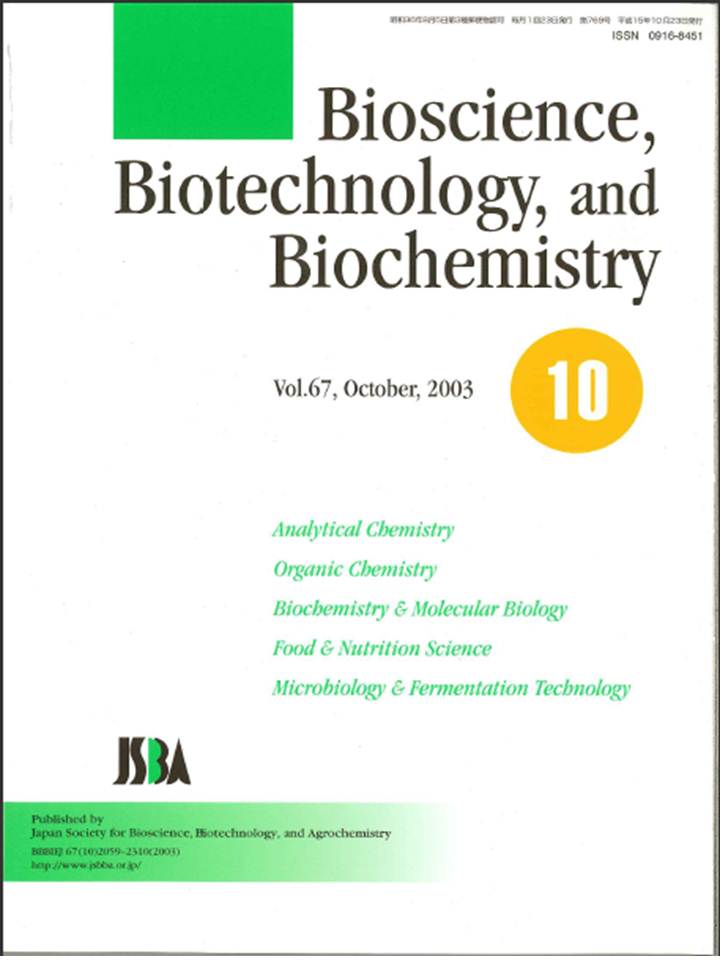Volume 67, Issue 10
Displaying 1-41 of 41 articles from this issue
- |<
- <
- 1
- >
- >|
Organic Chemistry Regular Papers
-
2003 Volume 67 Issue 10 Pages 2154-2159
Published: 2003
Released on J-STAGE: October 28, 2003
Download PDF (203K) -
2003 Volume 67 Issue 10 Pages 2183-2193
Published: 2003
Released on J-STAGE: October 28, 2003
Download PDF (407K) -
2003 Volume 67 Issue 10 Pages 2210-2214
Published: 2003
Released on J-STAGE: October 28, 2003
Download PDF (263K) -
2003 Volume 67 Issue 10 Pages 2215-2223
Published: 2003
Released on J-STAGE: October 28, 2003
Download PDF (346K) -
2003 Volume 67 Issue 10 Pages 2224-2231
Published: 2003
Released on J-STAGE: October 28, 2003
Download PDF (251K) -
2003 Volume 67 Issue 10 Pages 2240-2244
Published: 2003
Released on J-STAGE: October 28, 2003
Download PDF (221K)
Organic Chemistry Note
-
2003 Volume 67 Issue 10 Pages 2269-2272
Published: 2003
Released on J-STAGE: October 28, 2003
Download PDF (163K)
Biochemistry & Molecular Biology Regular Papers
-
2003 Volume 67 Issue 10 Pages 2075-2082
Published: 2003
Released on J-STAGE: October 28, 2003
Download PDF (502K) -
2003 Volume 67 Issue 10 Pages 2091-2099
Published: 2003
Released on J-STAGE: October 28, 2003
Download PDF (314K) -
2003 Volume 67 Issue 10 Pages 2106-2114
Published: 2003
Released on J-STAGE: October 28, 2003
Download PDF (592K) -
2003 Volume 67 Issue 10 Pages 2115-2123
Published: 2003
Released on J-STAGE: October 28, 2003
Download PDF (545K) -
2003 Volume 67 Issue 10 Pages 2139-2144
Published: 2003
Released on J-STAGE: October 28, 2003
Download PDF (197K) -
2003 Volume 67 Issue 10 Pages 2145-2153
Published: 2003
Released on J-STAGE: October 28, 2003
Download PDF (465K) -
2003 Volume 67 Issue 10 Pages 2167-2175
Published: 2003
Released on J-STAGE: October 28, 2003
Download PDF (355K) -
2003 Volume 67 Issue 10 Pages 2203-2209
Published: 2003
Released on J-STAGE: October 28, 2003
Download PDF (744K) -
Structural Features of N-Glycans Linked to Glycoproteins from Oil Palm Pollen, an Allergenic Pollen*2003 Volume 67 Issue 10 Pages 2232-2239
Published: 2003
Released on J-STAGE: October 28, 2003
Download PDF (357K) -
2003 Volume 67 Issue 10 Pages 2254-2261
Published: 2003
Released on J-STAGE: October 28, 2003
Download PDF (1039K)
Biochemistry & Molecular Biology Notes
-
2003 Volume 67 Issue 10 Pages 2262-2265
Published: 2003
Released on J-STAGE: October 28, 2003
Download PDF (306K) -
PEG-Inhibitor Conjugates: Application of Diphenyl α-Aminoalkylphosphonate to Removal of Chymotrypsin2003 Volume 67 Issue 10 Pages 2273-2276
Published: 2003
Released on J-STAGE: October 28, 2003
Download PDF (185K) -
2003 Volume 67 Issue 10 Pages 2277-2279
Published: 2003
Released on J-STAGE: October 28, 2003
Download PDF (390K) -
2003 Volume 67 Issue 10 Pages 2291-2293
Published: 2003
Released on J-STAGE: October 28, 2003
Download PDF (332K) -
2003 Volume 67 Issue 10 Pages 2294-2296
Published: 2003
Released on J-STAGE: October 28, 2003
Download PDF (418K) -
2003 Volume 67 Issue 10 Pages 2300-2303
Published: 2003
Released on J-STAGE: October 28, 2003
Download PDF (141K)
Biochemistry & Molecular Biology Communication
-
2003 Volume 67 Issue 10 Pages 2307-2310
Published: 2003
Released on J-STAGE: October 28, 2003
Download PDF (409K)
Food & Nutrition Science Regular Papers
-
2003 Volume 67 Issue 10 Pages 2068-2074
Published: 2003
Released on J-STAGE: October 28, 2003
Download PDF (660K) -
2003 Volume 67 Issue 10 Pages 2083-2090
Published: 2003
Released on J-STAGE: October 28, 2003
Download PDF (724K) -
2003 Volume 67 Issue 10 Pages 2100-2105
Published: 2003
Released on J-STAGE: October 28, 2003
Download PDF (188K) -
2003 Volume 67 Issue 10 Pages 2176-2182
Published: 2003
Released on J-STAGE: October 28, 2003
Download PDF (904K)
Food & Nutrition Science Notes
-
2003 Volume 67 Issue 10 Pages 2266-2268
Published: 2003
Released on J-STAGE: October 28, 2003
Download PDF (132K) -
2003 Volume 67 Issue 10 Pages 2280-2282
Published: 2003
Released on J-STAGE: October 28, 2003
Download PDF (126K) -
2003 Volume 67 Issue 10 Pages 2297-2299
Published: 2003
Released on J-STAGE: October 28, 2003
Download PDF (150K)
Microbiology & Fermentation Technology Regular Papers
-
2003 Volume 67 Issue 10 Pages 2059-2067
Published: 2003
Released on J-STAGE: October 28, 2003
Download PDF (1475K) -
2003 Volume 67 Issue 10 Pages 2124-2131
Published: 2003
Released on J-STAGE: October 28, 2003
Download PDF (609K) -
2003 Volume 67 Issue 10 Pages 2132-2138
Published: 2003
Released on J-STAGE: October 28, 2003
Download PDF (2208K) -
2003 Volume 67 Issue 10 Pages 2160-2166
Published: 2003
Released on J-STAGE: October 28, 2003
Download PDF (753K) -
2003 Volume 67 Issue 10 Pages 2194-2202
Published: 2003
Released on J-STAGE: October 28, 2003
Download PDF (1629K) -
2003 Volume 67 Issue 10 Pages 2245-2253
Published: 2003
Released on J-STAGE: October 28, 2003
Download PDF (916K)
Microbiology & Fermentation Technology Notes
-
2003 Volume 67 Issue 10 Pages 2283-2285
Published: 2003
Released on J-STAGE: October 28, 2003
Download PDF (403K) -
2003 Volume 67 Issue 10 Pages 2286-2287
Published: 2003
Released on J-STAGE: October 28, 2003
Download PDF (329K) -
2003 Volume 67 Issue 10 Pages 2288-2290
Published: 2003
Released on J-STAGE: October 28, 2003
Download PDF (151K) -
2003 Volume 67 Issue 10 Pages 2304-2306
Published: 2003
Released on J-STAGE: October 28, 2003
Download PDF (564K)
- |<
- <
- 1
- >
- >|
